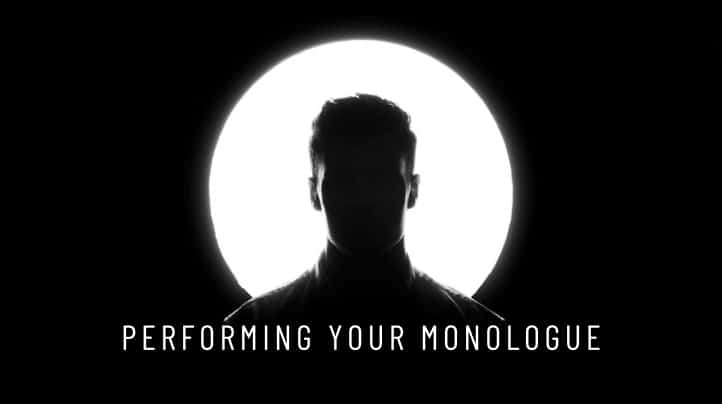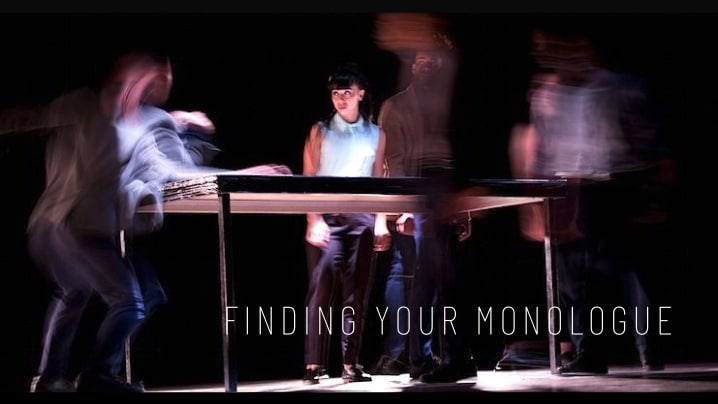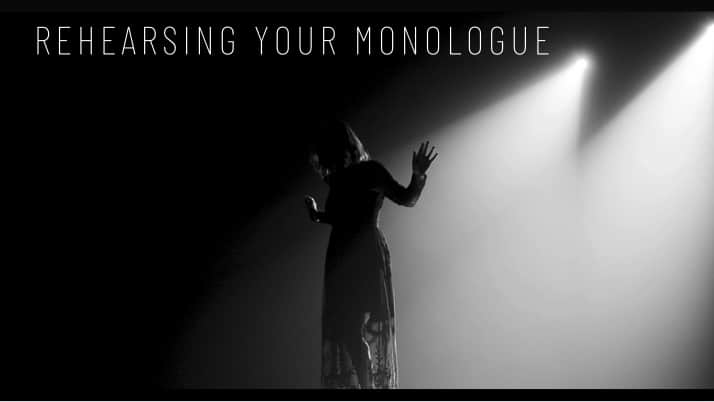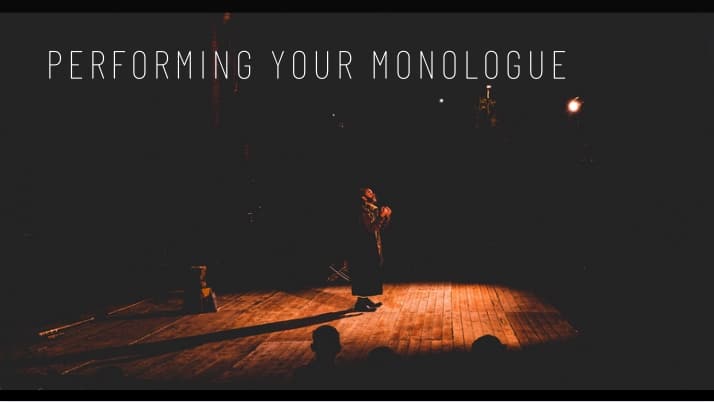Performing Your Monologue
Monologue Blogger’s Performing Your Monologue is designed to help you with drama class, self-taped auditions and in person castings.
We provide an overview of essential monologue basics whether you are a beginning actor, or would like a recap, if you consider yourself more advanced.
MB’s Performing Your Monologue guide has been broken down into three fundamental parts for an easier reading experience.
Each section will walk you through different phases of monologue acting.
Part 1: Finding Your Monologue
Part 2: Rehearsing Your Monologue
Part 3: Performing Your Monologue
Finding Your Monologue
“Trusting Your Intuition”
You need to search for a monologue that will rattle your intuition. It is sort of like an alarm bell going off inside you.
When something inside of you clicks, connects, and relates to the monologue you read, you are receiving clues from your intuition.
That is the area you work from as an actor.
Trust yourself. Trust what you connect to when you read monologues.
Reading Plays
The more plays you read, the more characters you will discover. Eventually, you will come across a monologue that strikes you with the desire to perform it.
You might ask yourself, “What kind of plays should I read?” Well, other than the written work we share here on Monologue Blogger, we highly recommend reading plays by Ibsen, Strindberg, Eugene O’Neill, and Chekhov, the forefathers of modern drama. Visit the works not only of present day writers (there are so many great ones), but also read Shakespeare and the ancient Greeks.
Such wonderful writers will help you understand the foundation of what you need to know about character, relationships, atmosphere, circumstances, and so much more.
Educate yourself and learn about dramatic action, conflict, and structure. When you understand more deeply about specific aspects of the drama, you will become more efficient at maximizing your role in a given scene.
The more you absorb, the better acting choices you could potentially make for your role.
It’s a good way to get connected to specific time periods and to expand your understanding of the evolution of different societies, cultures, and classes.
Fighting Monologue Fear
Monologue fear may exist for you, but it doesn’t have to.
It’s important to understand that if your nerves are making themselves known to you, that is actually a good thing.
It means you care about the work you’re doing. That’s not to say if you aren’t getting nervous that your work means any less.
Acknowledging the fact that you care about the work you do is obviously a positive thing to keep in mind in the first place.
You may get nervous because you are looking at the so called “largeness” of the monologue. When you sit down to eat a meal, you don’t take the entire meal in your mouth and swallow it whole.
Instead, you cut it into smaller pieces in order to chew it and then swallow the food. The same theory applies here with your monologue. Rather than trying to swallow the entire monologue, break it down by cutting it into smaller pieces.
The way you break your monologue down is strategic, but quite simple. Break your monologue down into beats.
Concentration
Now that you have your monologue beats marked. The next important element to keeping your nerves in check is simply your concentration.
When you are concentrated, your nerves become secondary. You are no longer focusing on being nervous, but are instead focused on what your character is doing.
Focus on the doing of what your character is involved in.
Is he/she making dinner? Then that’s what you should be focusing on, making dinner. Is your character putting on their shoes? Then that is what you should be focusing on, putting on your shoes.
By concentrating on the doing, you will help remove the concentration on your nerves and any other nonsense unnecessarily floating around in your mind.
Relaxation
Concentration and relaxation go hand in hand. Give yourself a few moments of conscientious breathing, sort of like a small dose of meditation.
Try some breathing exercises that may help you produce more inner calm for yourself.
Don’t get caught up in spending hours burning your energy in order to relax, because by the time you get to perform your monologue, you are reaching for straws.
A few minutes of gentle breathing and loosening up will suffice to give you inner calm and direct your focus.
Find what works best for you.
Monologue Blogger’s Quick Starter Guides
On Monologue Blogger we have a growing collection of monologues from contemporary plays you can choose from at any time.
Here are some quick monologue starter guides to help you with your search:
- Published Plays You Won’t Find Anywhere Else
- 20 Contemporary Plays for Teen Drama Students
- 30 Contemporary Plays for Young Adults
- 1 Act Play Dramas from Published Plays
Monologue Blogger’s Staff Picked Monologues
This section of monologues make room for solid material when auditioning.
ANOTHER STORY WRITTEN
Moe has never made a serious commitment with his girlfriend or career, and finally makes the realization that he needs to act.
THINKING OF SOMEONE ELSE
Toya realizes its time to pull away from the woman she loves because she feels different.
SINGLE HAPPY MOMENT
Doug and Priscilla are on the run for their lives, and in a moment of calm, Doug tells Priscilla how much he loves her.
FIVE MONTHS LATER
During the middle of the night Carlston wakes up to hear his ex-girlfriend screaming wild obscenities at him.
WHAT NEVER WAS
Serena’s band falls apart just as they are creating their debut album in the recording studio.
THE NOTES
Lucas works for a for a private company that even he doesn’t exactly know what it’s about.
CARTWHEEL LIFE
Riza’s boyfriend has a tattoo that provides her with a philosophy that may improve her relationship with her mother.
NO IS BETTER THAN SILENCE
After leaving her boyfriend without notice, Mickey finds Kyra in their local diner with an entirely new life.
CATCHING SUMMER
Pam and her boyfriend are trying to escape their current dwelling, when Pam’s boyfriend Teddy over his fear of turtles.
FOR ALL WE’VE GOT
Luna feels as though her life is headed downward and is freaking out for a way to figure out her future.
LITTLE FLYING SOLDIERS
Pete talks to a college student about why he sells books on a table out on the sidewalk.
LAST DAY OF JUNE
After a botched attempt at suicide, June’s neighbor visits her and discovers something frightening.
WINTER WILL NEVER END
Jason watches the woman of his dreams celebrate being officially married.
TREAT ME NICE
Corinne loves her mother, but doesn’t feel as though they have much of a loving relationship.
EXTRA GARLIC
Mario opens up to a customer about why it matters to him that he cooks the way he cooks in his own kitchen.
BEAUTIFUL DAY
Linda wishes she were attractive and longs for the day in which she can consider herself beautiful, but that all may change when she meets a stranger.
FOOD ON THE TABLE
Chuck has been wrongfully accused of stealing from the company he works for, but he defends his innocence.
JULIA
Dr. Ava is someone who specializes in helping patients understand their spiritual visions, but her encounter with Julia proves to be difficult.
DIE DOWN
Sheila explains to her fiancé the damaged nature she has with her father.
TEN YEARS GOING ON YESTERDAY
A therapy moderator shares her own gripping story on an incident that took place with her beloved son.
SECOND LOOK
Cher is getting older and feels as though she is losing her appeal to men in comparison to when she was a bit younger.
Rehearsing Your Monologue
“Discovering Your Character”
By now, you have read through a number of monologues over a period of time, and you’ve come upon one that you finally feel you can connect with.
First Impression
In order to fully connect with your intuition, it is always advisable that when you first sit down to read your monologue, you read it alone, without distraction. You need to leave yourself completely open to the first time experience you will receive with the material.
This is called your first impression.
Every monologue you read will be different, and every character you play will be different therefore, the process you take when approaching your character will also be different.
Keep yourself open to the monologue upon your first reading of it.
Find Connections
You need to find connections within you in relation to your monologue. You start with yourself. There really is no other way to begin because you need to play your own chords. You certainly can’t play on someone else’s heart. You can only play your heart, as the character. Therefore, you begin with you.
Certain questions you may ask yourself will not stimulate you at all, yet other questions will trigger something real inside of you.
Continue to contemplate, make choices, daydream, all the while blending these ideas and thoughts with those of your character.
Developing the Given Circumstances
Having read over the monologue, you may be instantly struck by the inner conflict of your character. You may begin asking yourself a series of questions to connect and get closer to the person you are portraying.
Questions are limitless and will come about from your own curiosities.
At this stage, your questions will hold more value to you as an actor than the answers.
As you weigh your imaginative questions for yourself, continue to read your monologue over again. Read it over with such thoughts and let it play on you.
Find the root of empathy and understanding between yourself and your character. Eventually your thoughts will emerge; you will begin to think about their thoughts and that is where the real magic occurs.
If you see that there are not so many similarities between you and your role, that’s a good thing. Also, explore the differences. The differences between you and your character are just as important.
The Moment Before
The idea of the moment before is to have a life force already taking place before you utter your first bit of monologue.
What was your character doing before they entered the room? What sort of day did your character have? Retrace your day in character, using your imagination, and lead yourself up to the point in time wherein you begin your monologue.
There is a life taking place prior to the first word you utter. That internal living will provide gravity to your work when you speak the first word of your monologue.
Working a moment before helps you maintain the line of action for your monologue.
The Moment After
In the same way there is a moment before, there is also a moment after.
Your monologue does not end when you stop speaking. There needs to be a ‘next moment’ occurring inside of you that you are inwardly steering towards when you do finish speaking your monologue.
Where is your character headed? Expecting? Are they closer or further away from what they want?
Where you arrive at the end of your monologue should not be where you were at the beginning.
There should be an evolution that takes place, and if the writer does not supply one, then it is up to you to create such an evolution for yourself.
As for the moment after, keep in mind that it is impossible to predict what will happen to your character in their immediate future, just as we cannot predict in what way life will reveal itself to us three minutes from now.
The moment after is the final intention the character makes, which will lead into the very next moment. Even though it is not seen or heard, it should exist within you.
Relationships
The story of your character can also unfold by understanding the relationships that surround you within the monologue and script. Even the relationships that make room for discussions of people you may never come in contact with directly in the story.
Understanding your relationship with people helps define your character.
The way in which you show your true self to your mother will be quite different from the way in which you reveal yourself to your local bank teller.
These are sides of your personality and character and can be considered keys to developing and discovering your character from your monologue when you think in those terms.
Environment, Time Period, Accents
A person born and raised in Japan is going to act quite differently than someone born and raised in the Bronx.
The styles of clothing will differ as will the language and speech patterns.
People from Huntington, New York, will speak differently than people from Monticello, New York. Regional speech also plays a role in character research and will prove to influence your character’s expression.
Maybe your character is from Ireland but has an English father and a Spanish mother. This, too, will influence your character.
These are all things to consider when rehearsing your monologue. Accents can be great to play around with, but the best place to start would be with your own or a dialect that you feel comfortable speaking in. You’ve already got to work on to prepare the material when auditioning; it’ll be best to choose material that you can do in your own accent.
Physicality
The behavior and mannerisms, the physical movements that make your character tick, are also things that create character.
This can be something as subtle as a smile that differentiates from someone else’s smile.
Does your character walk and talk a certain way as a cover for how they are truly feeling inside?
You never know what you might learn and want to use for your monologue.
Getting Off Book
Getting off book is more than just knowing your lines. It’s really about freeing yourself from overthinking, in order to express yourself fully.
When you have to think about what your next line is from your monologue, you are pulling yourself out of character and instantly finding yourself playing an actor who can’t remember their dialogue.
When you strain to remember the words, tension builds up in you both emotionally and physically, making it difficult to flow.
There are a ton of solid relaxation exercises out there. You should always keep your body loose, so your energy flows with less restriction and your work has more impact when you express it.
Memorizing Your Monologue
1. Get Physical
Do a physical activity like washing the dishes or cleaning a room.
While you are in physical motion, go over your lines without trying to give them any meaning. Keep the text nearby so that whenever you drop a line, you can quickly refer to the monologue. It’s a good idea to avoid straining to remember your words.
The point of this exercise is to begin learning your lines without giving them much thought. This exercise will also free you up with your behavior and give you additional ease of expression physically.
Acting is about behavior. The more lucid and less constricted you are physically, the more fully you will be able to express yourself.
It’s a circular effect. Less tension will increase sharper concentration, and sharper concentration will increase relaxation.
2. Voice Play & Tempo
Play around with your monologue. Don’t give it any importance whatsoever.
Go over your monologue in the following ways:
- As fast as you can, as slow as you can.
- Try speaking your monologue in a different voice.
- Say your lines in a robotic way.
3. Write It Out
Write out your monologue a bunch of times. Do it often, and it will slowly seep into your memory.
There isn’t much technique to writing out your monologue other than just to simply write it out. It will help because it is a slower process of digesting the words and sentences.
You may even find yourself thinking over certain parts of the monologue because of this slower process, and that’s a good thing.
Improvising Your Monologue
You improvise your character’s intentions and the imaginary circumstances they exist in.
You can improvise in your own words from the point of view of your character. You may make discoveries that were hidden within the subtext of the monologue.
Suddenly, you may find yourself more connected to the piece with a subconscious understanding you feel in your bones.
This will only strengthen your connection to the material, and if you forget your lines at some point in an audition while performing, you will have the confidence to punch through any sort of deer-in-headlights moment.
Movement
Depending on the audition situation (what the casting director asks of you, the size of the room), you will want to show the physical life of your character through movement.
Remaining stationary, either by standing or sitting, can come off as lifeless and static.
There are times when it will be important to remain in one position for a monologue, depending on the imaginary circumstances of your character, but more often than not, it will be a wise decision to have your monologue choreographed.
Choreographing Your Monologue
The more common term is ‘blocking’.
Choreography is a nice word because it feels like movement rather than an obstruction. The definition of choreography is a sequence of steps and movements.
It will be entirely up to you and your best judgment to piece together the movement of your monologue.
Trust your impulses. When you work through your monologue, pay attention to when you move. Act on such movements and begin to piece together what works.
Always aim to work from your intuition when it comes to monologue movement. If you feel the need to stand each time you reach a line in your monologue, then trust that impulse and stand. See where it takes you.
Working out the choreography in this way, will lead to a more organic process of realizing the material.
Entrances
If your character at the beginning of your monologue makes an entrance, you do not need to literally go out into the hallway and enter the room to start your monologue.
What you will need to do is simply go off to one side of the room and enter. You can also turn your back or use your profile and turn to enter the monologue.
You don’t want to waste anyone’s time, and you want to be ready to go at the drop of a hat. Make your entrance with a slight change of your body or by taking a few steps into the scene when speaking your first bits of dialogue.
Keep It Simple
The first thing you will want to keep in mind is to not do too much. Yes, it’s a good idea to have monologue movement, but you don’t want to create too much movement where you become a distraction.
Keeping it simple can be as subtle as walking up to an imaginary window and saying a line, before coming back and sitting down.
It can be as simple as starting your monologue sitting and then standing midway through, only to go back to sitting down again at the end.
Subtle movement when auditioning has more impact.
Oftentimes, creating subtle movement will go a long way for your monologue and help to keep the casting director involved.
Size of the Room
Whether you are performing your monologue for a play or a film, keep things subtle and in relation to the size of the room.
If you happen to audition in a room that can barely fit a table and chair, you will have to be ready to make physical adjustments to your monologue on the spot.
Be ready for such adjustments.
Actors need to be flexible and should already be prepared for tiny or large performance rooms. Have such situations already worked out for yourself in rehearsal prior; this way, you are good to go for such last minute tweaks.
In a good situation, the set might even surprise and inspire you, but this isn’t always the case, and therefore you must be prepared to adapt and do your work to the best of your ability, no matter the audition setting.
Being Open
A casting director or filmmaker may give you directions even before you say your first line. They may also give you direction after you perform your monologue with the intention of you doing it a second time.
It’s very important that you always make yourself open and available to any suggestions given to you in the audition room.
Actors need to be good listeners and receptive to what is suggested. Commit to the direction given because sometimes a casting professional simply wants to see how well you take direction.
An actor cannot be afraid to change things at a second’s notice. Go for it and see what happens.
Aim Your Performance
Who are you indirectly ‘aiming’ your monologue at?
You can’t be in an audition room giving your performance to a wall with your back to the casting director or camera.
You need to be clear that, however structured the room you are performing in, that you will be sure you are able to be seen entirely.
Always angle and position yourself towards the camera and casting professionals so that they may see you appropriately.
There is no sense in entering the room and acting toward the side, if no one can totally see you.
Performing Your Monologue
“Building Your Courage”
In Part 3: Performing Your Monologue, we’ve decided to share a few steps for filming your monologue for an audition/practice when it comes to performing your monologue.
Filming Your Monologue Audition
Let’s say that you are asked to perform a monologue for an online submission. You have your monologue piece, and you need to put it online for a casting submission.
Where do you begin?
Camera
You have a few choices available to you. Again, this does depend on what the casting director expects from you based on their submission guidelines.
You can use a smart phone with a camera, a computer with a built in camera, or an actual digital camera that you can record your monologue audition with.
You must consider your FRAME. What is a frame? A frame is what the camera actually sees. You need to pinpoint exactly where you will be in relation to the eye of the camera.
For most auditions, the standard framing is what is called a Medium Close-Up. Usually, mid-chest to top of head should be most suitable, give or take an inch or two for how you wish to exactly frame.
Be sure you are in focus.
The camera is level with your eyes.
Keep your hair away from your face.
If you are filming yourself alone, that is fine. You may need to use tape to identify your mark. Using tape to know your mark will help keep you in frame.
You will know what the perimeters will be to keep yourself in frame, so you don’t accidentally step out of it.
Give yourself room so you don’t feel stuck in one place.
Tripod
Be sure to get yourself a decent tripod. A tripod is what the camera rests on. Even if you are using an iPhone, for example, you can get a tripod that will work well with keeping your phone in position and balanced correctly.
Lighting
Natural light works wonders. Be careful when using lamps because they have an orange tone that has the potential to distort the color of your face.
You can also rent or buy a small lighting package (three point lighting kit) to get the job done more accurately. You don’t need to be an expert cinematographer, but you should certainly demonstrate enough decent lighting to look sharp and bright on screen.
Stay away from shadowy, dark settings, and try to keep the background behind you simple and basic without a lot of object noise to distract casting professionals from seeing your work.
It’s always best to have the camera on you from a mid-shot to a close-up shot to capture enough of you.
Keep a light aimed at you to help capture your eyes.
Keep the background without any objects. Just a plain colored wall.
Audio
Audio can oftentimes get overlooked, but in actuality, it can be considered more important than visual. Without really great sounding audio, the work you do visually can get lost.
You can record your audition with in-camera audio, but if you would like to take things a step further, it is recommended that you purchase or rent a decent mic that will pick up quality sound.
Slate
Don’t rule yourself out in the first few seconds by doing a terrible slate.
Your slate is your first impression. You can only make a first impression once, so make sure you do your slate well.
Speak clearly, smile, but be genuine, not neurotic.
Make believe the camera is a friend you are smiling at.
Editing
Most computers today come with a decent editing program to capture video images.
The goal is to keep your file size as low as possible so that you may upload your file to the casting website as easily and quickly as possible. You may even be asked to email your video file.
If you are more ambitious, you can always purchase Final Cut Pro or Adobe Premiere and have tremendous options when it comes to editing your video audition. You can even use color correcting tools with these programs to enhance the visual quality of your audition.
Submission
Based on all the guidelines given to you by casting, it’s time to submit.
Once you’ve exported your video, upload it online, whether it be to a casting network, a video platform site like Vimeo or Youtube, or an email.
What are the common mistakes you can stay away from with self-taping?
Don’t make it too long. Don’t be on camera for ten seconds before you say your first line. A couple of seconds is fine, but cut out extra footage that doesn’t need to be there.
Keep in mind that casting directors only have so much time and that they are busy reviewing many other actor candidates.
What should you wear?
Dress to suggest the character you are playing. Be suggestive in your choices to give the casting director an idea of how you can be a good choice for the role.
Can you do some editing cuts?
It’s best to keep it to one shot only. A series of cuts can be a distraction, they want to see you act. Keep the camera on you at all times. Unless they have instructed you otherwise in their audition guidelines.
We hope you’ve enjoyed Monologue Blogger’s Performing Your Monologue guide. We only wish to provide suggestions we hope will help you along your creative journey.





